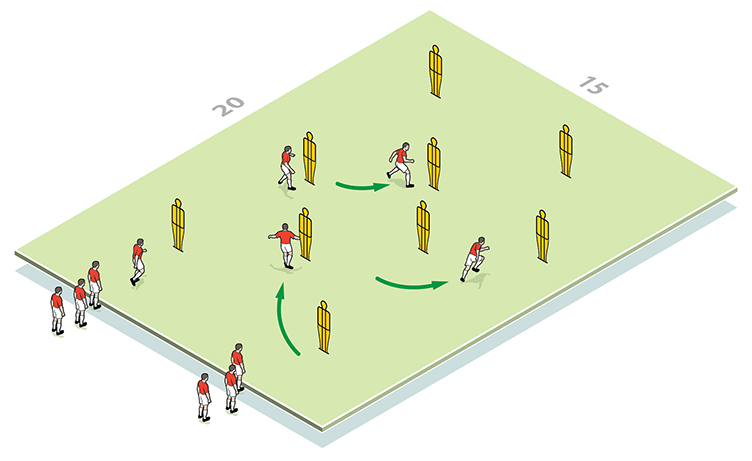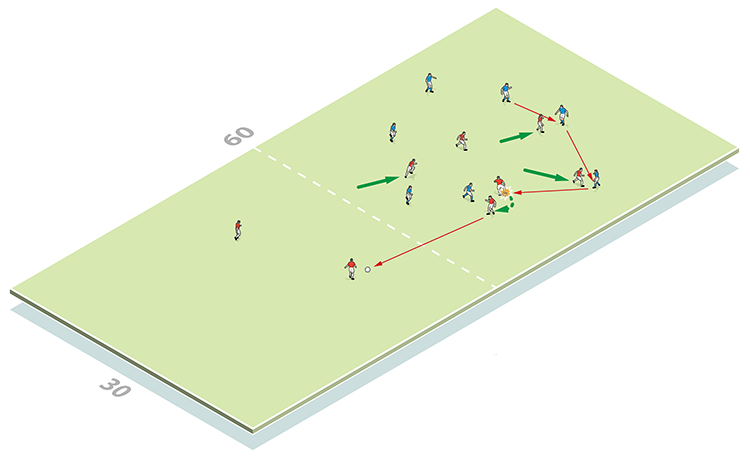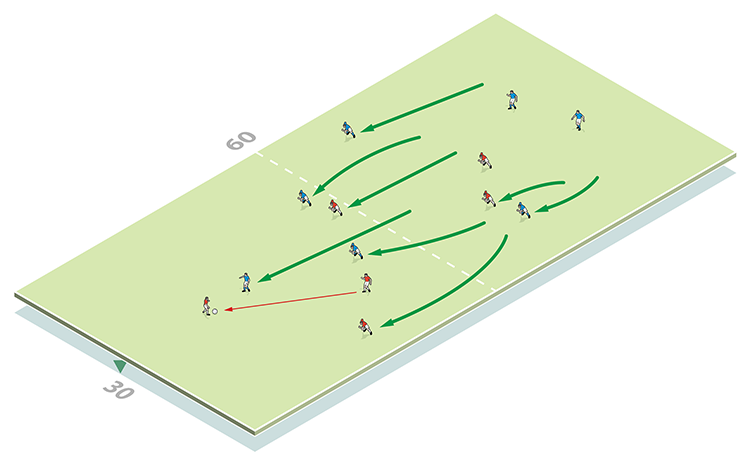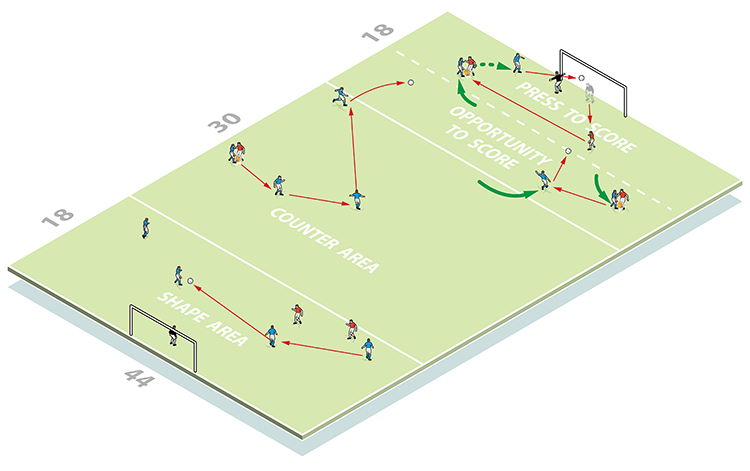Pressing
Pressing is important in all areas of the pitch. In this session we look at pressing technique, the relationships between players, and the value of winning the ball in different areas, with an emphasis on turning over possession and creating onward goalscoring chances.

| Area | Up to 76x44 yards |
| Equipment | Balls, cones, mannequins, goals |
| No. of Players | Up to 14 |
| Session Time | Pressing warm-up 15mins, Mannequin formation 10mins, 7v7 game 4x4mins, 11v11 game 15mins |
This session looks at the value of pressing in all areas of the pitch, with an emphasis on turning over possession and creating onward goalscoring chances.
In it, we look at pressing technique, the relationships between players, and the value of winning the ball in different areas.
It’s vital we practise pressing technique because, on average, the ball is turned over 360 times in a game – that’s four times per minute. Barcelona didn’t make their name through possession football, they made it through transitions and how quickly players can react to the possibilities brought about by a turnover, and that is at the heart of this session.
What do I get the players to do?
Pressing warm-up
To start, we place mannequins in a 20x15-yard area. Players run into the area, jockey a mannequin staying high or getting low in their stance, then run to the top edge, before coming back the other way (1). This is a simple pressing drill that rehearses approach and technique. After a while we remove the mannequins and give balls to half the players. Now opponents press the man without tackling, before moving on to the next target.
1

Mannequin formation
Gauging the likely formation of upcoming opponents, we set mannequins in that shape – I have used 4-2-3-1 in the example. Players enter individually from the other side of the pitch with the instruction of approaching and pressing the mannequin relevant to the man they will be marking (2). With individual instruction, we rehearse showing inside or outside, angles, threats and general approach.
2

7v7 game
In a 60x30-yard playing area, the ball is played into one team, who pass it between themselves. Five opposition players now come across to press the ball. When possession is turned over, the ball must be passed back to the waiting pair (3a). Speed of transition here is important – the five working players must return to their half to help defend the ball, while five of the other team also move across to press in a new 7v5 (3b). Which team can react quickest? If the ball goes dead always restart with the team last out of possession.
3a

3b

11v11 game
This is a played on a narrowed half-pitch plus penalty area. Each area requires players to play and behave in a certain way. The ability to press remains important, albeit whilst exploring other tactical qualities (4).
4

• Opportunity to score area - The second area is the space in which the greatest goal danger arises. Defenders must not give the ball away in this space, while attackers should always be looking to shoot if the ball comes to them here
• Counter area - The Counter Area represents the space where our intention is to catch the opposition out of position. When turning over the ball here, we want to see only two or three touches before it is moved forward into the Opportunity to Score area
• Shape area - The fourth area is where, when defending, we must never give the ball away
What are the key things to look out for?
Players need to understand who is around them - recognising the trigger and how play develops from that – as well as learning when to pass and when to go alone.
We also want good technique, communication and bravery. And, naturally, players must enjoy the session if they are to make the most of what it teaches them.
Editor's Picks
Attacking transitions
Deep runs in the final third
Using the goalkeeper in build-up play
Intensive boxes drill with goals
Penetrating the final third
Creating and finishing
My philosophy
Pressing initiation
Compact team movement
Coaches' Testimonials

Alan Pardew

Arsène Wenger

Brendan Rodgers

Carlos Carvalhal

José Mourinho

Jürgen Klopp

Pep Guardiola

Roy Hodgson

Sir Alex Ferguson

Steven Gerrard
Coaches' Testimonials

Gerald Kearney, Downtown Las Vegas Soccer Club

Paul Butler, Florida, USA

Rick Shields, Springboro, USA

Tony Green, Pierrefonds Titans, Quebec, Canada
Join the world's leading coaches and managers and discover for yourself one of the best kept secrets in coaching. No other training tool on the planet is written or read by the calibre of names you’ll find in Elite Soccer.
In a recent survey 92% of subscribers said Elite Soccer makes them more confident, 89% said it makes them a more effective coach and 91% said it makes them more inspired.
Get Monthly Inspiration
All the latest techniques and approaches
Since 2010 Elite Soccer has given subscribers exclusive insight into the training ground practices of the world’s best coaches. Published in partnership with the League Managers Association we have unparalleled access to the leading lights in the English leagues, as well as a host of international managers.
Elite Soccer exclusively features sessions written by the coaches themselves. There are no observed sessions and no sessions “in the style of”, just first-hand advice delivered direct to you from the coach.









